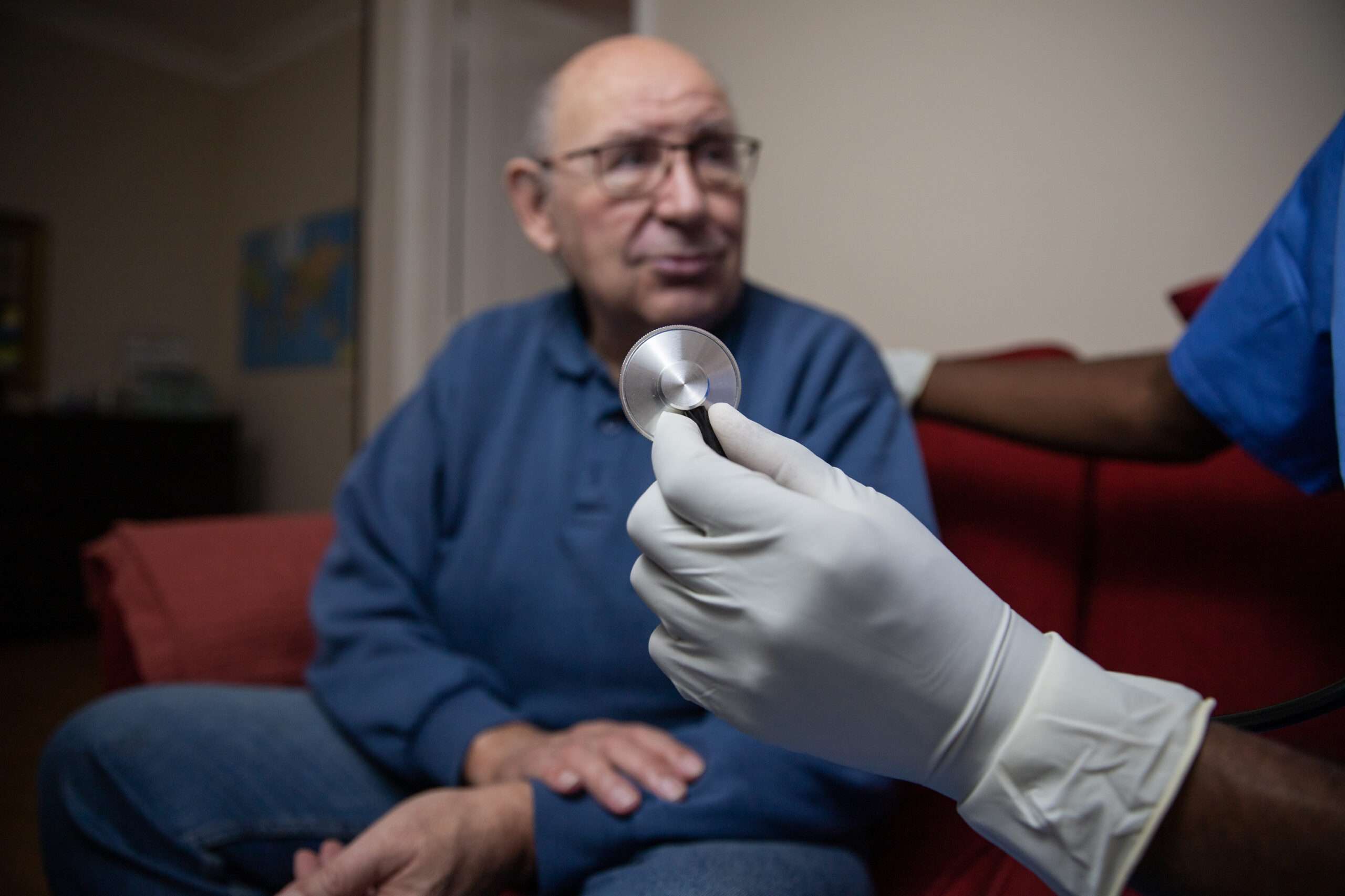As the healthcare industry faces increasing regulatory changes, margin pressures, and rising costs, companies like CVS Health and Humana are feeling the squeeze. Experts emphasize the need for value optimization, with low-cost care settings showing the most potential for success. Inbound Health and Allina Health are leading the way with their innovative Elevated Care at Home (ECH) program. Developed in response to the COVID-19 pandemic, ECH offers an alternative to traditional hospital stays and post-acute care services, improving outcomes while addressing capacity and cost challenges. Together, Inbound Health and Allina Health are transforming transitional care to enhance both quality and affordability.
-
ViVE 2025 Wrapped: AI, Care at Home, and the New Wave of Healthcare Innovation

ViVE 2025 brought together more than 8,000 healthcare leaders, innovators, and changemakers to explore technology’s transformative role in healthcare. This year’s jam-packed agenda tackled pressing topics like artificial intelligence (AI), interoperability, and value-based care. Our team was thrilled to be part of the action in Nashville, engaging in meaningful discussions about innovations reshaping care delivery. Here’s what stood out:
AI Takes Center Stage
AI predictably dominated conversations, signaling its expanding role in healthcare. The application of AI-driven automation is proving invaluable in enhancing clinician workflows and reducing administrative burdens, allowing providers to focus more on direct patient care rather than paperwork.
However, broader AI adoption hinges on thoughtful technology design that fosters trust, addresses ethical concerns, and ensures provider autonomy. Health systems want to invest in AI solutions that empower providers, not create additional challenges. The main takeaway: AI solutions must support the mission of delivering high-quality, patient-centered care.
The Next Phase of Healthcare Transformation
The dialogue at ViVE reflected an industry looking beyond the COVID-19 era, focusing on the next five to ten years. The shift isn’t just about adopting new technology, it’s ensuring healthcare becomes more effective, efficient, and accessible. The industry has seen its share of tech that overpromises and underdelivers, leading to frustration and wasted resources.
The future belongs to solutions that integrate seamlessly into existing workflows, providing actionable insights without adding complexity. While AI and digital health tools are playing an increasingly important role, they don’t replace clinical care. Instead, technology should enable health systems to rethink traditional models and provide care in ways that weren’t possible before—and crucially, enabling providers’ ability to deliver high-quality patient care and exceptional outcomes.
Home-based Care is Here to Stay
Safe and accessible in-home advanced care programs are no longer a nice-to-have, they’re essential. But scaling them requires robust, trustworthy, and reliable technology to support both providers and patients. The infrastructure behind home-based care must be as strong as the clinical expertise driving it.
Our COO, Dave Zimmerman, joined a dynamic ViVE 2025 panel on the evolving landscape of post-acute care at home and its direct connection to value-based care. Key takeaways included:
Care at home is value-based care. Bringing advanced care to the home is financially tied to patient outcomes, making efficiency and effectiveness crucial.
Provider efficiency is a top priority. Organizations are optimizing provider workflows to ensure seamless, effective care at home.
Earlier patient identification is key. Identifying and directing patients to acute and post-acute home-based care sooner improves outcomes and lowers costs.
The business case is strong. Early adopters see increased capacity, stronger patient relationships, better adherence, and fewer readmissions.
Payer buy-in remains a challenge. Proving cost-effectiveness is key to overcoming fee-for service barriers and driving adoption.
Care at home complements traditional hospitals. It expands capacity, optimizes resources, and delivers high-quality care where patients feel most comfortable.
Until Next Year, ViVE!
After four days of thought-provoking discussions, panels, and connections, we left Nashville inspired about what’s ahead. ViVE 2025 reinforced the next chapter of healthcare will extend beyond hospital walls.
The question isn’t whether advanced care at home programs will take a central role—it’s how we ensure the technology, processes, and strategies supporting it work in unison to enable better care without adding unnecessary complexity. We’re excited to keep pushing boundaries, driving transformation, and working alongside our peers to make care at home the standard.
Want to learn how Inbound Health helps health systems scale high-quality care-at-home programs? Get in touch today.
-
Improving Patient Outcomes with Acute Hospital Care at Home

Preliminary Analysis of Hospital Care at Home Performance Outcomes
This preliminary analysis examines performance outcomes in patients discharged to Inbound Health’s Hospital Care at Home program, which meets CMS Acute Hospital Care at Home requirements, within a Minneapolis-based health system.
Patients in Inbound’s program had a lower 30 day readmission rate compared to matched patients based on severity of illness. Also, the mean length of inpatient stay was shorter with the Inbound Health cohort of patients.
We improved care and created greater efficiency for our patients, families, and healthcare systems.
-
Hospital-at-Home Saves Both Lives and Money, but Congress Must Act to Keep It Alive

When it comes to ongoing healthcare initiatives aimed at improving care outcomes, the Acute Hospital Care at Home (AHCAH) program exceeds expectations by also increasing patient comfort, lessening the burden on hospitals, and lowering spending.
While the AHCAH program was launched by the Centers for Medicare and Medicaid Services (CMS) in response to the COVID-19 pandemic and its overwhelm of hospitals, the improved outcomes and lower spending seen with the program have lasted even after the pandemic ended. Offering in-patient level care at home allows hospitals to care for more patients, decreases a backlog of filled beds, and lessens the need for unnecessary procedures and treatments resulting from delayed care. The AHCAH program has shown the benefits it offers to the healthcare system, but it will nevertheless expire if Congress does not act by the end of the year.
Extending the AHCAH Program
The AHCAH program has already been extended once; it was initially planned to last only through the pandemic’s emergency period, but the Consolidated Appropriations Act of 2023 extended AHCAH through December 31st, 2024. Since the time of its expiration has arrived, Congress must once again act to keep in action this initiative that improves outcomes while also lowering healthcare costs, a win for patients and carers alike.
While the deadline is quickly approaching, its renewal is not entirely out of the question. The Telehealth Modernization Act of 2024, which has bipartisan support in the House and Senate, includes an extension of the AHCAH waiver through 2029 that is supported by the American Medical Association. The hospital-at-home waiver offers hospitals reimbursement for providing at-home care to their patients with Medicare and Medicaid. The waiver also removes the requirement that a nurse must be present 24/7.
The Impact of AHCAH’s Expiration or Extension
The AHCAH program is no small feat and has become a cornerstone of Medicare programs. There are over 350 approved hospitals across more than 130 health systems that implement this innovative form of care delivery, and the expiration of the AHCAH program could be detrimental to these systems that rely on providing care-at-home services.
All patients can benefit from AHCAH. Rather than overcrowd hospitals, sometimes to the point where patients receive emergency care in hallways because no rooms are available, patients can be moved to their homes to complete the remainder of their care. For the aging population, care at home offers the opportunity for them to age in place, something that three-quarters of those in the United States over the age of 50 desire.
Knowing the universal benefits of the AHCAH, the expiration of this model can hurt all patients, but especially those with dementia, social barriers, and physical/sensory disabilities—for these individuals, care at home can make all the difference in their comfort, adherence to treatment, and treatment success.
AHCAH also offers healthcare workers a glimpse into the lives of their patients, which offers greater insights that can further improve the care they’re capable of providing.
Additionally, care-at-home programs demonstrate their superiority when it comes to lowering spending while improving healthcare outcomes. A report by CMS found that the mortality rate for AHCAH was lower for all 25 Medicare Severity Diagnostic Related Groups (MS-DRGs) they analyzed and significantly lower for 11 of these 25 MS-DRGs. Spending is lower, as well, with care-at-home shown to have lower Medicare spending in the 30 days after treatment for more than half of the top 25 MS-DRGs.
An extension of the AHCAH initiative gives health systems time to implement a care-at-home program or continue improving and expanding those that are already in place. It allows these facilities to provide for patients who can and want to be treated at home, increasing the care capacity of hospitals without increasing the costs required to provide this care.
How Inbound Health Can Help
If the AHCAH program is extended, it will provide your healthcare system with a vital opportunity to bring the benefits of care-at-home to your patient population, and Inbound Health can help.
Inbound Health partners with health systems to build, launch, and operate acute and post-acute care at home programs, allowing you to take the guesswork out of the best way to bring to life a successful AHCAH program that improves outcomes and lowers spending.
When it comes to the AHCAH program, the ball may currently be in Congress’s court, but you don’t have to wait to learn more about how Inbound Health helps health systems.
References
Fact Sheet: Report on the Study of the Acute Hospital Care at Home Initiative | CMS. (2024, November). Cms.gov. https://www.cms.gov/newsroom/fact-sheets/fact-sheet-report-study-acute-hospital-care-home-initiative
H.R.7623 – 118th Congress (2023-2024): Telehealth Modernization Act of 2024. Congress.gov. https://www.congress.gov/bill/118th-congress/house-bill/7623
Hospital at home saves lives and money: CMS report. (2024). American Medical Association; https://www.ama-assn.org/delivering-care/population-care/hospital-home-saves-lives-and-money-cms-report
Davis, M. R. (2022). 77 Percent of Older Adults Want to Remain in Their Homes as They Age. AARP. https://doi.org/1062105/3752820195
-
Innovative Solutions to Hospital Overcrowding

Hospital overcrowding has become a widespread issue in healthcare systems worldwide, straining resources, compromising patient care, and challenging the resilience of medical professionals. The problem is complex, stemming from factors like population growth, aging demographics, limited hospital capacity, and seasonal outbreaks. However, innovative solutions are emerging, offering hope for alleviating the strain and improving healthcare delivery.
The Challenges:
Reduced Quality of Care: Overcrowded hospitals often lead to limited resources, increased wait times, and compromised quality of care. Medical staff may find it challenging to provide individualized attention and timely treatments.
Increased Risks of Infections: Congested hospitals increase the risk of hospital-acquired infections, posing a threat to both patients and healthcare workers. Containing the spread of infections becomes increasingly difficult in crowded environments.
Burnout Among Healthcare Professionals: Overworked medical staff, faced with the pressure of managing high patient volumes, are at risk of burnout, which can negatively impact their well-being and job satisfaction, ultimately affecting patient care.
Higher Costs: Hospital overcrowding is not only detrimental to patient health but also incurs substantial financial costs for healthcare systems. Increased demand for services, coupled with resource shortages, drives up operational expenses.
Creative Solutions to Hospital Overcrowding:
Despite the complexities of hospital overcrowding, several innovative solutions are being implemented to the widespread problem.
Telemedicine and Remote Patient Monitoring: Telemedicine offers a viable solution to alleviate overcrowding by providing remote consultations and monitoring for non-emergency cases. Patients can receive medical advice and follow-up care without the need for in-person visits, reducing the burden on hospitals.
Community-Based Care Initiatives: Community-based healthcare programs aim to divert non-urgent cases away from hospital emergency departments by providing alternative care options. These initiatives include urgent care centers, mobile clinics, and home healthcare services, effectively easing the strain on hospital resources.
Advanced Predictive Analytics: Predictive analytics tools leverage data insights to forecast patient admission rates, enabling hospitals to anticipate peak demand periods and allocate resources more efficiently. By proactively managing patient flow, hospitals can mitigate overcrowding and improve operational efficiency.
Hospital-at-Home Programs: Hospital-at-home models deliver acute care services to patients in their own homes, offering an alternative to traditional hospitalization. With advances in technology and medical equipment, many treatments and monitoring procedures can now be administered outside hospital settings, reducing the need for inpatient beds.
Collaborative Partnerships: Collaborative efforts between healthcare institutions, government agencies, and community organizations are essential for addressing the root causes of hospital overcrowding. By pooling resources and expertise, stakeholders can develop comprehensive strategies to enhance healthcare access, optimize resource utilization, and improve patient outcomes.
Hospital overcrowding is a significant challenge for many healthcare systems worldwide, jeopardizing patient safety, straining resources, and impacting the well-being of medical professionals. However, through innovation and collaboration, solutions are emerging to mitigate the effects of overcrowding and improve healthcare delivery. From telemedicine and community-based care initiatives to advanced analytics and hospital-at-home programs, creative approaches are reshaping the future of healthcare, offering hope for a more efficient, patient-centered system. By embracing these solutions and fostering partnerships across the healthcare ecosystem, we can work towards a future where hospital overcrowding is no longer a barrier to quality care.
Explore how Inbound Health empowers healthcare systems to launch, expand, and manage acute and post-acute care at home programs. -
The Results Are In: CMS’s Report on the Acute Hospital at Home Initiative

The Acute Hospital Care at Home (AHCAH) initiative was launched during the COVID-19 public health emergency to address rising waiting times in hospitals, improve the quality of care received by patients, and protect essential workers. The Consolidated Appropriations Act, 2023 (CAA, 2023) extended the waivers and flexibilities of the AHCAH until the end of 2024 with the requirement that the Centers for Medicare & Medicaid Services (CMS) conduct a study and analysis on the AHCAH initiative. On September 30th, 2024, CMS released the findings of this study comparing AHCAH with brick-and-mortar hospital inpatient programs; detailed below are the highlights of their findings.
Quality of Care
Beginning with quality of care, the CMS study found that mortality rate was lower for those receiving care under the AHCAH initiative compared to those who were treated for the same conditions in brick-and-mortar inpatient facilities. Additionally, hospital-acquired conditions (HACs) were less common in hospital at home individuals for all six types of HACs evaluated.
As for readmissions, AHCAH was slightly superior to brick-and-mortar facilities, with AHCAH having a significantly higher rate of readmissions for two MS-DRGs while inpatient facilities have a significantly higher rate for three MS-DRGs.
Costs
To compare the cost of utilization, the study focused on metrics such as length of stay per episode and Medicare spending within 30 days of hospital discharge. The study found that AHCAH inpatients had a length of stay that was slightly longer, but the average amount of Medicare spending in the 30 days following treatment was lower for each care episode.
Of note, the differences in patient selection criteria and clinical complexity prevent CMS from stating, with certainty, that AHCAH resulted in lower Medicare spending compared to inpatient care at a brick-and-mortar facility.
Of note, the differences in patient selection criteria and clinical complexity prevent CMS from stating, with certainty, that AHCAH resulted in lower Medicare spending compared to inpatient care at a brick-and-mortar facility.
Patient Experience
Through virtual listening sessions and anecdotal information, the study concluded that patients and caregivers alike had a positive experience with the care provided through the AHCAH initiative. Clinicians, as well, mirrored this positive feedback in regard to their ability to provide care services.
Future Considerations
CMS’s study highlights the need for more targeted measures of quality, cost, and utilization in order to better understand how AHCAH compares to brick-and-mortar inpatient care. However, the continuation of the AHCAH initiative beyond December 31st, 2024—when the CAA, 2023 expires—is contingent on Congressional action.
There are currently several bills in Congress that would extend the CMS waiver between 2 to 5 years. With the CMS study complete and its favorable results for the AHCAH released, we await news regarding the extension of the CMS waiver.
If you’re intrigued by the findings of the CMS study, learn how Inbound Health enables healthcare systems to launch, operate, and scale acute and post-acute care programs.
Reference
Fact Sheet: Report on the Study of the Acute Hospital Care at Home Initiative | CMS. (2024). Cms.gov. https://www.cms.gov/newsroom/fact-sheets/fact-sheet-report-study-acute-hospital-care-home-initiative
-
The Value of Hospital-at-Home Programs for Healthcare Systems and Payers

As healthcare evolves, hospital-at-home programs are quickly becoming a game changer for both healthcare systems and payers. These innovative programs provide acute and post-acute care directly in patients’ homes, offering several advantages beyond traditional hospital settings.
One major perk of hospital-at-home programs is their potential for significant cost savings. By moving care out of traditional hospital settings and into patients’ homes, these programs cut down on various inpatient-related costs. This includes reducing facility fees, overhead expenses, and eliminating unnecessary tests and procedures. The result? A more cost-effective model that saves insurance companies money and lowers out-of-pocket costs for patients.
Hospital-at-home programs also help reduce the risk of hospital readmissions. With continuous monitoring and follow-up care, providers can keep a close eye on patients’ conditions and catch potential issues before they become serious. This proactive approach prevents complications and ultimately leads to fewer readmissions. For payers, this means lower costs and better patient outcomes.
Patients often prefer receiving care in their own homes rather than in a hospital. This preference boosts patient satisfaction, which positively impacts payer organizations. Higher patient satisfaction means better member loyalty and can enhance the overall reputation of insurance companies. So, not only do these programs improve patient experiences, but they also help with member retention and attracting new clients.
Additionally, hospital-at-home programs play a significant role in population health management. By focusing on preventive and proactive care at home, these programs tackle the root causes of acute episodes, manage chronic conditions effectively, and encourage wellness and self-care. This approach aligns with the broader goals of modern healthcare systems, which aim to improve health outcomes on a population level. Hospital-at-home programs offer a strategic advantage for both patients and insurance providers. They provide substantial cost savings, reduce readmissions, enhance patient satisfaction, and support effective population health management. As the healthcare industry continues to advance, integrating these programs into care strategies will lead to better outcomes and more efficient use of resources, making them a crucial part of the future of healthcare.
Discover how Inbound Health benefits patients, healthcare systems, and payers.

